Quantitative Aptitude Questions with answers and Solutions for SSC CPO- SI in CPMF Exam. Maths MCQs Mock Test for free online practice of SI CAPF Exam.
Practice Set : Mathematics (Quantitative Aptitude)
Questions : 50
Medium : English
Level : SSC CPO SI Exam
All Type and topic MCQs – Solved by short tricks
Immediate display of Answer and Solution
New Practice of 50 Questions in every attempt
Results
#1. The least number to be subtracted from 36798 to get a number which is exactly divisible by 78 is
When 36798 is divided by 78, remainder = 60
The least number to be subtracted = 60
#2. The ratio of cost price and selling price is 5 : 4, the loss percent is :

#3. Mohan lends Rs 500 to John and a certain sum to Tom at the same time at a simple interest of 8% per annum. If in 4 years, he altogether receives Rs 210 as interest from the two, then the sum of money he lent to Tom was

#4. The average weight of A, B and C is 45 kg. If the average weight of A and B be 40 kg and that of B and C be 43 kg, then the weight (in kg) of B is :

#5. Out of seven given numbers, the average of the first four numbers is 4 and that of the last four numbers is also 4. If the average of all the seven numbers is 3, then the fourth number is :

#6. Find the simplest value of  (given
(given

#7. The ratio of the ages of A and B at present is 3 : 1. Four years earlier the ratio was 4 : 1. The present age of A is :

#8. A motor boat covers a certain distance downstream in a river in 3 hours. It covers the same distance upstream in 3 hours and a half. If the speed of water is 1.5 km/h, then the speed of the boat in still water is :

#9. . Four years ago, the ratio of A’s age to B’s age was 11 : 14 and four years later their age will be in the ratio 13 : 16. The present age of A is :
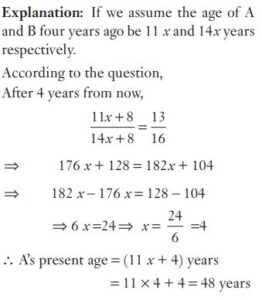
#10. If 20% of A = 50% of B, then what per cent of A is B?

#11. Walking at the rate of 4 kmph a man covers certain distance in 2 hours 45 minutes. Running at a speed of 36.5 kmph the man will cover the same distance in how many minutes?

#12. The cost price of 36 books is equal to the selling price of 30 books. The gain percent is :

#13. The value of is 
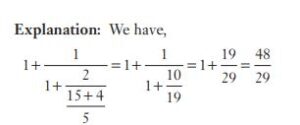
#14. 1 + 2 + 3 + … + 49 + 50 + 49 + 48 + … + 3 + 2 + 1 is equal to

#15. The average pocket money of 3 friends A, B, C is Rs. 80 in a particular month. If B spends double and C spends triple of what A spends during that month and if the average of their unspent pocket money is Rs. 60, then A spends (in Rs.)
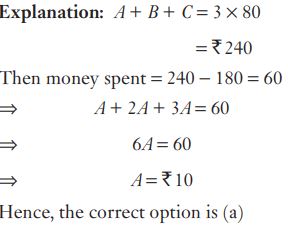
#16. A man purchased an article and sold it to B at a profit of 25% and B sold it to C at a loss of 10% and C paid Rs 675 for it. For how much did A purchase it (in Rs)?

#17. By how much does  exceed
exceed  ?
?

#18. A man spends 75% of his income. His income increases by 20% and his expenditure also increases by 10%. The percentage of increase in his savings is :

#19. The distance between two cities A and B is 330 km. A train starts from A at 8 a.m. and travels towards B at 60 km/hr. Another train, starts from B at 9 a.m. and travels towards A at 75 km/hr. At what time will they meet?

#20. At some rate of simple interest, A lent Rs 6000 to B for 2 years and Rs 1500 to C for 4 years and received Rs 900 as interest from both of them together. The rate of interest per annum was :

#21. In one litre of a mixture of alcohol and water, water is 30%. The amount of alcohol that must be added to the mixture so that the part of water in the mixture becomes 15% is :

#22. A and B can complete a piece of work in 8 days, B and C can do it in 12 days, C and A can do it in 8 days. A, B and C together can complete it in :
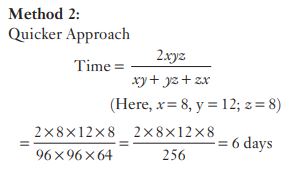
#23. Two places P and Q are 162 km apart. A train leaves P for Q and simultaneously another train leaves Q for P. They meet at the end of 6 hours. If the former train travels 8 km/hour faster than the other, then speed of train from Q is :
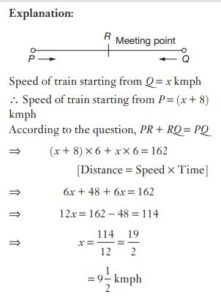
#24. A boat goes 20 km downstream in one hour and the same distance upstream in two hours. The speed of the boat in still water is :
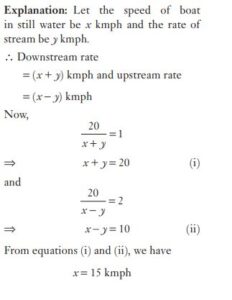
#25. In a school, the ratio of boys to girls is 4 : 3 and the ratio of girls to teachers is 8 : 1. The ratio of students to teachers is :
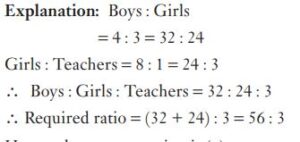
#26. A number is first decreased by 20%. The decreased number is then increased by 20%. The resulting number is less than the original number by 20. Then the original number is
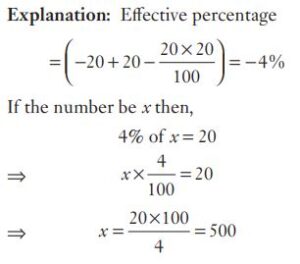
#27. The cost price of 100 books is equal to the selling price of 60 books. The gain percentage/loss percentage is :

#28. A takes three times as long as B and C together to do a job. B takes four times as long as A and C together to do the work. If all the three, working together can complete the job in 24 days, then the number of days, A alone will take to finish the job is
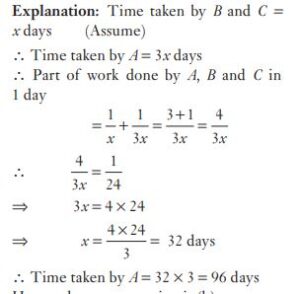
#29. Two successive discounts of 10% and 5% is given on a bill of Rs 110. Find the net amount of money payable to clear the bill. (Answer to the nearest rupee)

#30. In a class 60% of the student pass in Hindi and 45% pass in Sanskrit. If 25% of them pass in at least one subject, what percentage of the students fail in both the subjects?
Explanation: 25% of students pass in at
least one subject, i.e., they pass in one or
both subjects.
∴ Percentage of students who don’t pass
or fail in both subjects
= (100 − 25) % = 75
#31. The number, whose square is equal to the difference between the squares of 975 and 585 is :
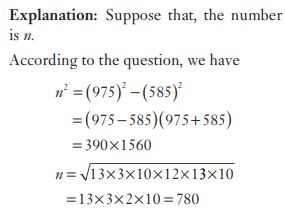
#32. The product of the LCM and the HCF of two numbers is 24. If the difference of the numbers is 2, then the greater of the number is
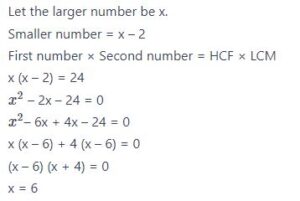
#33. The value of ( is
is
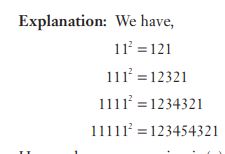
#34. A sum of money becomes  of itself in 3 years at a certain rate of simple interest. The rate per annum is :
of itself in 3 years at a certain rate of simple interest. The rate per annum is :

#35. A shopkeeper sold his goods at half the list price and thus lost 20%. If he had sold on the listed price, his gain percentage would be.

#36. A tap can fill a tank in 6 hours. After half the tank is filled, three more similar taps are opened. What is the total time taken to fill the tank completely?

#37. Arvind spends 75% of his income and saves the rest. His income is increased by 20% and he increases his expenditure by 10%. Then the increase in savings in percentage is

#38. A man travels for 5 hours 15 minutes. If he covers the first half of the journey at 60 km/h and rest at 45 km/h. Find the total distance travelled by him.
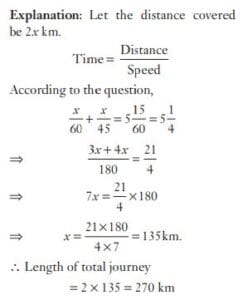
#39. If Rahim deposited the same amount of Rs x in a bank at the beginning of successive 3 years and the bank pays a simple interest of 5% per annum, then the amount at his credit at the end of 3rd year will be :

#40. A man walking at the rate of 5 km/hr crosses a bridge in 15 minutes. The length of the bridge (in metres) is
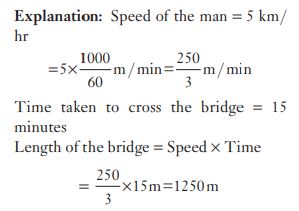
#41. Given A is 50% larger than C and B is 25% larger than C, then A is what per cent larger than B?

#42. The simplified value of  is
is
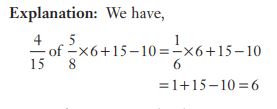
#43. A water tank can be filled by a tap in 30 minutes and another tap can fill it in 60 minutes. If both the taps are kept open for 5 minutes and then the first tap is closed, how long will it take for the tank to be full?

#44. A number when divided by 221 leaves a remainder 64. What is the remainder if the same number is divided by 13?

#45. The average of 15 numbers is 7. If the average of the first 8 numbers be 6.5 and the average of last 8 numbers be 9.5, then the middle number is :

#46. By selling an article for Rs 102, there is a loss of 15%, when the article is sold for Rs 134.40. The net result in the transaction is

#47. 5 – [4 – (3 – (3 – 3 – 6))] is equal to
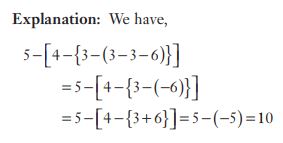
#48. Two numbers are in the ratio 1 : 3 If their sum is 240, then their difference is :
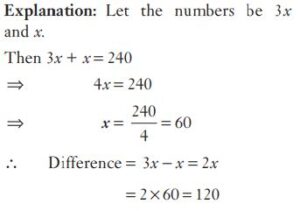
#49. The LCM of two multiples of 12 is 1056. If one of the number is 132, the other number is

#50. If the price of a commodity is increased by 50%, by what fraction must its consumption be reduced so as to keep the same expenditure on its consumption?
